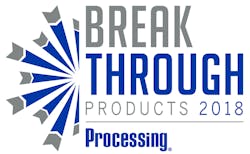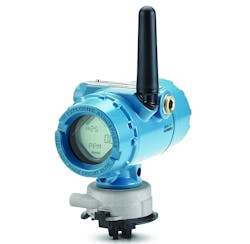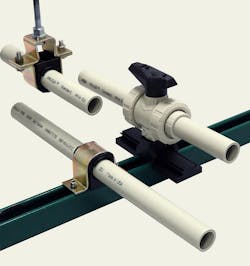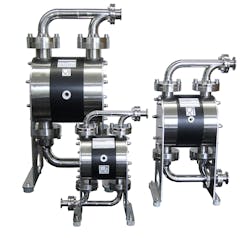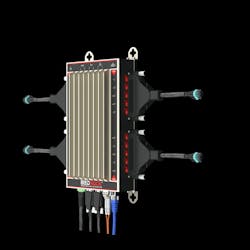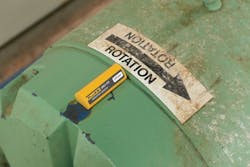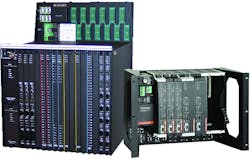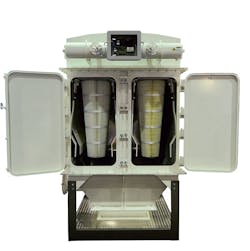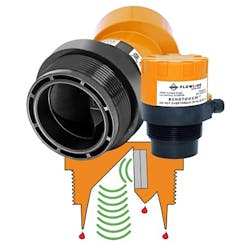2018 Processing Breakthrough Products Awards Winners
Processing serves professionals who develop, manage, maintain and improve industrial processing operations to maximize product quality, output and profitability. With this mission, our annual Processing Breakthrough Products awards honor innovative technology solutions introduced to the process industries within the past year that help our readers perform their jobs better, quicker and more cost-effectively.
From more than 30 nominations, Processing is proud to present the 10 winners of the 2018 Breakthrough Products Awards. The manufacturers recognized this year developed novel solutions that help end users effectively manage tough processing environments, meet stringent safety and cybersecurity needs, solve installation and maintenance issues, reduce unplanned downtime, and drive overall profitability.
From the world’s first self-calibrating temperature sensor to the first reflective ultrasonic level sensors that work in condensation, these awards celebrate major innovations as well as incremental improvements in technology that keep the process industries moving forward.
Congratulations to the 2018 winners!
Rosemount 928 Wireless Gas Monitor
Emerson Automation SolutionsHydrogen-Sulfide, or H2S, gas detection has become an integral component of modern flame and gas detection systems. However, for remote locations where H2S leaks are prevalent, installing and commissioning fixed-point gas detectors can be costly and difficult to accomplish with existing infrastructure and control systems. These remote applications include any site where high sulfur content fossil fuels are extracted, refined, stored or transported. Currently, the primary method of detecting H2S at these sites is the use of portable gas detectors worn by personnel on site. This, however, only provides real-time detection without advanced notification of critically toxic environments personnel are entering. The Rosemount 928 Wireless Gas Monitor provides this early H2S monitoring for operators, which would have been too difficult or costly to achieve in the past.
Conventional fixed-point gas detectors require wiring and additional infrastructure for proper installation. This can be costly and difficult for owners of facilities that are already in operation. The introduction of a wireless gas monitor provides a viable solution for this issue, saving an estimated 60 percent in initial installation compared to a conventional wired gas detector. The Rosemount 928 Wireless Gas Monitor simplifies the installation, lowers overall cost of ownership and most importantly leverages the Emerson WirelessHART technology currently implemented at more than 30,000 sites worldwide. This allows operators currently using various wireless measurement devices to seamlessly incorporate gas monitoring at their facilities. What truly separates the 928 from the competition — aside from industry-leading performance, accuracy, battery life and wireless communication integrity — is the ability to effectively deploy life-saving gas monitoring at any site easily and at a moment’s notice.
iTHERM TrustSens Self-calibrating Temperature Sensor
Endress+HauserThe iTHERM TrustSens hygienic resistance temperature detector (RTD) is the world’s first self-calibrating temperature sensor. TrustSens’ self-calibration process functions in situ and provides the necessary documentation to meet the conformance requirements for various regulatory agencies.
Traditionally, calibration cycles for standard temperature sensors in critical service are every six to 12 months. This leaves the potential for undetected drift in the sensor output between cycles. Such undetected drift could lead to product quality issues or even a complete loss of the production run.
Many hygienic and aseptic processes require equipment cleaning on a regular basis with sterilize-in-place (SIP) procedures, typically after every batch. With TrustSens, the temperature sensor is calibrated during every SIP cycle. TrustSens, therefore, eliminates the risk of undetected calibration drift, revenue loss from bad or quarantined batches, production downtime during a corrective action investigation, and diversion of personnel from revenue generation to investigative activities.
TrustSens is the world’s first truly self-calibrating RTD with full traceability. It has an integral, high precision ceramic reference mounted at the same physical location as the Pt100 sensor. The Curie Point of the reference material — that is, the temperature at which its ferromagnetic properties abruptly change — has been specifically formulated for 118° C. During SIP cycles, where temperatures of > 121° C are achieved, the change in ferromagnetic property is detected electronically as the temperature passes the 118° C threshold.
Simultaneously, the electronics in TrustSens’ integral transmitter capture and record the temperature being measured by the Pt100. Comparison between these two values results in a calibration identifying drift in the temperature sensor. If the measured deviation is within customer-specified limits there is no concern. If the deviation is outside the specified limits, TrustSens issues an alarm or error message, which is also displayed via a local LED.
Stress Less Pipe and Valve Support System
GF Piping SystemsMechanical stress on plastic piping systems is one of the leading causes of premature failures and leaks. GF Piping’s Stress Less Pipe and Valve Support System offers a solution to this costly problem by providing proper pipe support and eliminating stress at support locations, thereby maximizing pipe service life.
The system includes Stress Less Pipe Guides in sizes ½-inch to 8 inches (IPS and metric sizes) and Stress Less Valve Supports in sizes 3/8-inch to 2 inches (IPS and metric sizes. Both pipe guides and the valve support base can be mounted on any flat surface or on standard strut channel.
The system is recommended for all thermoplastic piping systems (e.g. PP, PVDF, HDPE, PVC, CPVC, ABS), including those in stringent, high-purity facilities and corrosive environments. Piping systems in critical applications, with aggressive media, with indoor-to-outdoor transitions or those subject to wide temperature variations will especially benefit.
Traditional pipe and valve support products on the market induce stress on plastic piping systems because they do not prevent overtightening; do not allow movement; do not provide proper support during an earthquake; and can have sharp metal edges that can damage pipe.
GF’s pipe guide and valve support system addresses each of these issues, thereby eliminating stress transfer to plastic pipe caused by normal thermal expansion and contraction, improper installation or seismic events. The new system uses low friction pipe guide inserts, designed to be 3 millimeters (mm) larger than the pipe, to permit piping to slide freely in the axial direction during thermal expansion cycles. An outer steel hoop supports pipe weight — even during a strong earthquake — and also acts as the only tightening mechanism to prevent any mechanical stress during installation. A unique valve support also allows valves to move ±3 inches in two directions, while maintaining proper support.
Almatec MM Series AODD Pump
Almatec, part of PSG, a Dover companyAlmatec designed its MM Series Air-Operated Double-Diaphragm (AODD) Pump to meet the strict standards, regulations and operational requirements that govern the food and beverage industry. The use of food-grade wetted materials and a construction that allows easy and economical clean-in-place/sanitize-in-place (CIP/SIP) service enables the MM Series pumps to meet the hygienic standards of the European Commission’s EC 1935/2004 and U.S. Food and Drug Administration (FDA) regulations while also conforming to the ATEX 2014/34/EU directive for operation in potentially explosive atmospheres. The result is a pump that achieves low-shear fluid transfer, even with solid-laden fluids, good suction head and self-priming and dry-run capabilities. This makes the series ideal for use in the transfer and filling of beverages, sauces, toppings; dosing of food and beverage ingredients; processing of meat, pastry and dough, smoothies, fruit pulp and candies; and transfer and filling of cosmetics.
The most noteworthy differentiator for the MM Series pumps — with the "MM" standing for "modular metal" — is the modularity that provides for easy exchanging of different hygienic-manifold types, including Code A (screwed aseptic pipe connection), Code A2 (aseptic flange), Code A3 (aseptic pipe clamp connection), Code M (milk pipe connection), Code T (tri-clamp connection) and Code S (open butt-welding end for easy adaptability). The pump’s inlet and outlet configuration can be easily adjusted between "U-shape" (inlet and outlet on the same side) and "Z-shape" (inlet and outlet on opposite sides). The pump’s housing is constructed of stainless steel 1.4404 (SS316L) with the wetted surfaces available in a roughness of 3.2 µm or an optional 0.8 µm roughness. Other features include maintenance-free PERSWING P air-control system; smooth, seal-free diaphragms available in EPDM or PTFE/EPDM compound; no drives, rotating parts and shaft seals within the fluid; and optional stroke-counting and diaphragm-monitoring accessories.
Bedrock OSA Remote
Bedrock AutomationOil and gas, water and wastewater utilities and energy producers stand to benefit financially and operationally from the more intelligent and more open connectivity promised by the Industrial Internet of Things (IIoT). But with the requisite openness comes greater vulnerability to cyber threats, and remotely managed supervisory control and data acquisition (SCADA) operations are especially vulnerable.
The Bedrock OSA Remote solves this with a control system that has public key infrastructure (PKI) functionality designed into the hardware itself. The PKI authenticated by Bedrock’s certificate authority uses advanced signing and encryption technology similar to that used to secure military, aerospace and online financial transactions. It is the same advanced technology that Bedrock Automation has built into its flagship Bedrock Open Secure Automation system, but now available in a module that fits in the palm of the hand and is cost competitive with unsecure traditional PLCs and RTUs.
OSA Remote differentiates based on the depth of its cybersecurity protection, its control performance and its lower cost of acquisition and operation. Because competing controllers were designed before cybersecurity was an issue, they have no built-in security and rely on firewalls or other bolt-on protection. This is especially difficult to apply to remote sites; it is costly and largely ineffective.
The deep cybersecurity comes at no incremental cost above the control technology, which with multicore ARM processors has more bandwidth to run edge control and analytical software than competing systems. Other differentiators include up to 20 channels of universal soft-selectable input/output (I/O), an embedded OPC UA server and free IEC 61131-3 engineering software.
Fluke 3561 FC Vibration Sensor
Fluke CorporationVibration monitoring is one of the most effective ways to detect potential equipment failures before they cause downtime. However, vibration analysis is complex, and it can be cost-prohibitive to place sensors on noncritical assets. The Fluke 3561 FC Vibration Sensor allows maintenance teams to improve uptime by adding remote, continuous vibration monitoring to virtually any rotating equipment. With a frequency range of 10 to 1,000 hertz (Hz), the 3561 FC detects and notifies users of conditional changes caused by critical faults like imbalance, misalignment, looseness and bearing wear, providing warning of impending equipment failure. Vibration data from the 3561 FC is wirelessly transmitted via the Fluke 3502 FC Gateway to Fluke Connect Condition Monitoring software, allowing maintenance teams to remotely monitor asset health anytime and virtually anywhere, whether on a desktop or a smart device.
The 3561 FC sensor is small enough to fit in hard-to-reach locations on equipment and affordable enough to install on many assets, providing a more comprehensive picture of equipment health. Installation and setup are simple, allowing technicians to start monitoring vibration on equipment in about an hour. The triaxial sensors deliver continuous measurements while the asset is in use, permitting maintenance technicians to remain at a safe distance away from dangerous rotating equipment. The Fluke Connect app allows teams to view and understand vibration data, enabling them to screen for potential equipment degradation. Fluke Connect Condition Monitoring (FCCM) software aggregates real-time and historical data from all Fluke Connect-enabled tools and sensors for a comprehensive picture of equipment health. The FCCM software also generates automatic alarms when assets experience conditional changes outside the Fluke Overall Vibration Severity scale parameters, notifying maintenance team members before issues become critical.
EcoStruxure Triconex Tricon CX
Schneider Electric
When the need for dependable safety has never been higher, Schneider Electric’s Tricon CX safety system better enables customers in the oil and gas, refining, petrochemicals, power and other hazardous industries to identify and control their operating risks in multiple applications, including emergency shutdown systems, burner management systems, high-integrity pressure protection systems (HIPPS) and fire and gas systems. It is the industry’s first dual-process safety and security-certified SIS, meaning it meets stringent requirements for safety, cybersecurity, risk reduction and continuous operation. New features and capabilities include:
Inherent system diagnostics and online module replacement for continuous safe operation
Improved ease of use and small form factor makes it ideal for high-hazard and extreme environments where
a reduced footprint is at a premium
More powerful and faster, which helps plant personnel better identify, plan and control risks
It is proven to speed project execution, reduce equipment damage, unscheduled downtime, production outages, safety incidents and injuries and improve regulatory and environmental compliance and financial performance.
A manufacturer’s primary objective is to drive operational profitability. So protecting the plant is often viewed as a necessary cost of business. The Tricon CX safety system changes that. First, it complies with the IEC 62443 standard, is certified by TÜV Rheinland for use in safety applications up to SIL 3 and is ISASecure EDSA certified. It is the industry’s first dual-certified safety system. Second, footprint is the most expensive component of any project. With its smaller size, triple modular redundancy, universal safety I/O and safety intelligent enclosures, it improves project execution while reducing costs. Third, because it leverages connectivity between systems, assets and people, it drives better real-time operating and business decisions. All told, it is the only safety system that provides measurable 100 percent return on investment (ROI) in fewer than six months while improving operational profitability by at least 5 percent. This allows customers to stop managing safety as a cost center and control it as a profit center.
Vertical Cartridge Filter (VCF)
Schenck ProcessThe Vertical Cartridge Filter provides the process industries with an efficient, energy-saving filtering system for multiple dust-removal applications. An easy-to-use cartridge clamp system simplifies replacement of the filter media, minimizing maintenance time and lowering overall cost of operation. The filter is also equipped with a smart timer, which includes an onboard sensor that reads the pressure drop across the filtering elements for on-demand cleaning. This results in reduced compressed air consumption and greater cartridge life. A standard radial inlet allows for excellent material separation during moderate air volume applications while the optional high-entry inlet with a pre-separation chamber is designed for optimal performance in high-volume systems. The chamber separates the largest powder particles safeguarding the media from excess loads of pollutants and guaranteeing longer media life. The Vertical Cartridge Filter provides the process industries with an efficient, energy-saving filtering system for multiple dust-removal applications.
A key feature of the Vertical Cartridge Filter is the ability to quickly remove and install the filter cartridges. In a matter of seconds an old cartridge can be removed and replaced with a new cartridge, saving customers significant maintenance time. Additionally, the robust design of the filter adds to its overall stability. Each unit is constructed with reinforced carbon steel that is rated for an industry-leading 6.4 psi Pred to handle the toughest of the combustible dust applications. A Pred 6.4 psi rating results in less vent area needed, lowering overall costs in comparison to other dust collectors on the market. The VCF has also been Pred validated through a full-scale, third-party explosion test.
EchoPod & EchoTouch Reflective Ultrasonic Level Sensors
Flowline Inc.Condensation is the most common variable in liquid level applications, and it degrades the measurement reliability of typical ultrasonic sensors, causing unstable readings, costly inspections and frustration. When droplets form on the transducer, they attenuate the acoustic signal. This weakens the signal strength and signal-to-noise ratio by up to 50 percent, greatly reducing its measurement range and reliability. As a result, noncontact level users have two choices, apply typical ultrasonic sensors and live with condensation-induced instability, or pay much more for radar sensors to address condensation. Until now. Reflective ultrasonic level sensors work in condensation. Here’s how. At the center of reflective ultrasonic technology is a simple fact. Unlike horizontal surfaces, substantial droplets can’t adhere to smooth vertical surfaces. By orienting the transducer vertically, condensation runs off the unimpeded transducer face. The unimpeded transmit and receive signals are redirected to and from the liquid off a 45-degree reflector thanks to gravity. As a result, reflective ultrasonic sensors provide reliable and cost-effective level measurement in condensing environments.
Like tides, the ebb and flow of condensation in process applications is continuous. Flowline’s patent-pending, reflective ultrasonic level sensors are the only ultrasonic sensors in the world that provide reliable and cost-effective level measurement in condensing environments. Other manufacturers have a flat, horizontal transducer face that collects signal-disrupting water droplets from condensation. As the signal strength and signal-to-noise ratio decrease, this causes measurement instability, which to the user occurs randomly and without obvious cause. It’s common to hear something like, "It worked great all winter. But during the humid summer months, we’re getting false tank alarms two to three times a day. Yet, when we inspect the level sensor, it’s functioning correctly, and nothing’s changed in the application?" Nothing but condensation. Flowline’s EchoPod and EchoTouch reflective ultrasonic level sensors provide a reliable and cost-effective noncontact measurement solution.
Stratus ztC Edge Computing Platform
Stratus TechnologiesIn today’s industrial environments, companies are faced with mounting pressure to be more efficient with fewer resources. At the same time, industrial technologies are becoming more powerful and more connected, yet are being deployed where there are little or no IT resources. The influx of data from these technologies and devices is driving the need for — and growth of — new edge computing infrastructure. ztC Edge is a zero-touch, fully virtualized and self-protecting computing platform, specifically designed for industrial edge environments. With built-in remote management and user-installable in less than an hour, ztC Edge significantly reduces the IT burden for virtualized computing at the edge. Since process industries cannot afford for applications on the plant floor to suffer downtime, Stratus ztC Edge is comprised of redundant nodes that act as a single system. With live migration of VMs, data replication, and redundant networking, it instantly provides protection for applications and data.
ztC Edge’s self-protecting and self-monitoring features help reduce unplanned downtime and ensure availability of business-critical industrial applications. Purpose-built for operational technology (OT), ztC Edge is easy to set up, configure and manage, with user-friendly tools and redundant, hot-swappable nodes that automatically verify compatibility and synchronize themselves.
